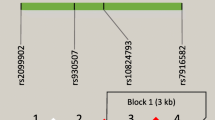Abstract
The recently described family of Toll-like receptors (TLRs) plays a major role in innate immunity by mediating inflammatory reactions against a wide array of pathogens. TLR-2 is reported to interact with various bacterial partial structures including lipoproteins, peptidoglycan, and lipoteichoic acid. Two polymorphisms of the TLR-2 gene have recently been described: Arg753Gln, correlated with the incidence of sepsis in a white population, and Arg677Trp, correlated with the incidence of lepromatous leprosy in an Asian population. Both polymorphisms, when inserted into expression vectors encoding for human TLR-2, reduced stimulation of Chinese hamster ovary cells by synthetic lipopeptides. We furthermore developed a rapid and inexpensive method for the detection of both single nucleotide polymorphisms based on restriction fragment length polymorphism. While no individuals carrying the Arg677Trp SNP were identified in a large group of whites, 9.4% of the study population were found to be heterozygous for the Arg753Gln polymorphism. This ratio is significantly higher than previously reported, and therefore detection of this polymorphism among patients may yield important information for the assessment of risk profiles regarding susceptibility to bacterial infections.



Similar content being viewed by others
Abbreviations
- CHO :
-
Chinese hamster ovary
- ELAM :
-
Endothelial cell/leukocyte adhesion molecule nuclear transcription factor κB luciferase reporter plasmid
- PCR :
-
Polymerase chain reaction
- RFLP :
-
Restriction fragment length polymorphism
- SNP :
-
Single nucleotide polymorphism
- TLR :
-
Toll-like receptor
References
Medzhitov R, Janeway CA (1997) Innate immunity: the virtues of a nonclonal system of recognition. Cell 91:295–298
Janeway, CA, Medzhitov R (2002) Innate immune recognition. Annu Rev Immunol 20:197–216
Beutler B, Du X, Poltorak A (2001) Identification of Toll-like receptor 4 (Tlr4) as the sole conduit for LPS signal transduction: genetic and evolutionary studies. J Endotoxin Res 7:277–280
Schwandner R, Dziarski R, Wesche H, Rothe M, Kirschning CJ (1999) Peptidoglycan- and lipoteichoic acid-induced cell activation is mediated by toll-like receptor 2. J Biol Chem 274:17406–17409
Schröder NW, Opitz B, Lamping N, Michelsen KS, Zähringer U, Göbel UB, Schumann RR (2000) Involvement of lipopolysaccharide binding protein, CD14, and Toll-like receptors in the initiation of innate immune responses by Treponema glycolipids. J Immunol 165:2683–2693
Hirschfeld M, Kirschning CJ, Schwandner R, Wesche H, Weis JH, Wooten RM, Weis JJ (1999) Cutting edge: inflammatory signaling by Borrelia burgdorferi lipoproteins is mediated by toll-like receptor 2. J Immunol 163:2382–2386
Takeuchi O, Kaufmann A, Grote K, Kawai T, Hoshino K, Morr M, Mühlradt PF, Akira S (2000) Cutting edge: preferentially the R-stereoisomer of the mycoplasmal lipopeptide macrophage-activating lipopeptide-2 activates immune cells through a toll-like receptor 2- and MyD88-dependent signaling pathway. J Immunol 164:554–557
Means TK, Wang S, Lien E, Yoshimura A, Golenbock DT, and Fenton MJ (1999) Human toll-like receptors mediate cellular activation by Mycobacterium tuberculosis. J Immunol 163:3920–3927
Takeuchi O, Hoshino K, Akira S (2000) Cutting edge: TLR2-deficient and MyD88-deficient mice are highly susceptible to Staphylococcus aureus infection. J Immunol 165:5392–5396
Echchannaoui H, Frei K, Schnell C, Leib SL, Zimmerli W, Landmann R (2002) Toll-like Receptor 2-Deficient Mice Are Highly Susceptible to Streptococcus pneumoniae Meningitis because of Reduced Bacterial Clearing and Enhanced Inflammation. J Infect Dis 186:798–806
Wooten RM, Ma Y, Yoder RA, Brown JP, Weis JH, Zachary JF, Kirschning CJ, Weis JJ (2002) Toll-like receptor 2 is required for innate, but not acquired, host defense to Borrelia burgdorferi. J Immunol 168:348–355
Arbour NC, Lorenz E, Schutte BC, Zabner J, Kline JN, Jones M, Frees K, Watt JL, Schwartz DA (2000) TLR4 mutations are associated with endotoxin hyporesponsiveness in humans. Nat Genet 25:187–191
Lorenz E, Mira JP, Frees KL, Schwartz DA (2002) Relevance of mutations in the TLR4 receptor in patients with gram-negative septic shock. Arch Intern Med 162:1028–1032
Lorenz E, Mira JP, Cornish KL, Arbour NC, Schwartz DA (2000) A novel polymorphism in the toll-like receptor 2 gene and its potential association with staphylococcal infection. Infect Immun 68:6398–6401
Kang TJ, Chae GT (2001) Detection of Toll-like receptor 2 (TLR2) mutation in the lepromatous leprosy patients. FEMS Immunol Med Microbiol 31:53–58
Hamann L, Schumann RR, Flad HD, Brade L, Rietschel ET, Ulmer AJ (2000) Binding of lipopolysaccharide (LPS) to CHO cells does not correlate with LPS-induced NF-kappaB activation. Eur J Immunol 30:211–216
Kirschning CJ, Wesche H, Merrill Ayres T, Rothe M (1998) Human toll-like receptor 2 confers responsiveness to bacterial lipopolysaccharide. J Exp Med 188:2091–2097
Lorenz E, Frees KL, Schwartz DA (2001) Determination of the TLR4 genotype using allele-specific PCR. Biotechniques 31:22–24
Okayama N, Fujimura K, Suehiro Y, Hamanaka Y, Fujiwara M, Matsubara T, Maekawa T, Hazama S, Oka M, Nohara H, Kayano K, Okita K, Hinoda Y (2002) Simple genotype analysis of the Asp299Gly polymorphism of the Toll-like receptor-4 gene that is associated with lipopolysaccharide hyporesponsiveness. J Clin Lab Anal 16:56–58
Agnese DM, Calvano JE, Hahm SJ, Coyle SM, Corbett SA, Calvano SE, Lowry SF (2002) Human toll-like receptor 4 mutations but not CD14 polymorphisms are associated with an increased risk of gram-negative infections. J Infect Dis 186:1522–1525
Bochud PY, Hawn TR, Aderem A (2003) Cutting edge: a toll-like receptor 2 polymorphism that is associated with lepromatous leprosy is unable to mediate mycobacterial signaling. J Immunol 170:3451–3454
Acknowledgements
This work was supported in part by grants from the German Bundesministerium für Bildung und Forschung to R.R.S. (CAPNetz) and Deutsche Forschungsgemeinschaft to R.R.S. and N.W.J.S. (Innate Immunity).
Author information
Authors and Affiliations
Corresponding author
Rights and permissions
About this article
Cite this article
Schröder, N.W.J., Hermann, C., Hamann, L. et al. High frequency of polymorphism Arg753Gln of the Toll-like receptor-2 gene detected by a novel allele-specific PCR. J Mol Med 81, 368–372 (2003). https://doi.org/10.1007/s00109-003-0443-x
Received:
Accepted:
Published:
Issue Date:
DOI: https://doi.org/10.1007/s00109-003-0443-x




